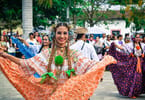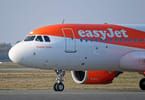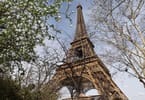KRALENDIJK, Bonaire – On a slow ascent to the surface of the water from 60 feet below, the dive master spots something thrilling along the reef and extends her hand with all five fingers wiggling excitedly. It’s a signal that can mean only one thing: octopus!
Scuttling around coral, the octopus quickly scrunches up into an eight-armed torpedo and squirts away. Soon, it stops to unfold itself on a sandy patch of the reef — almost as if to pose the best side of its bulbous, mushy head. Then, it camouflages into the seascape right before our eyes.
It’s a surprise to see how quickly the shape-shifter fades into the reef’s backdrop. But surprises tend to be the norm in this unusual marine park with a plentiful array of coral, fish and sea creatures. It doesn’t take many dives to find validation in the words on vehicle license plates back on land, dubbing Bonaire a “Diver’s Paradise.”
With more than 350 species of fish on a reef that circles the 111-square-mile island, divers tend to focus on making the most of water visibility that can extend to about 100 feet in mostly calm waters.
The predominant recreational activity here often requires the silent communication of hand signals, and it’s a quiet that’s also often present on land. Bonaire lacks loud discos, and there’s little demand for 2 a.m. last calls.
The island offers some nightlife with waterside restaurants, a small casino with $5 minimum blackjack and bars with acoustic-guitar players. But the bright lights you’ll see here at night will most likely be coming from underwater, as divers search for small, nocturnal sea creatures near shore.
Still, beyond diving and snorkeling, this small, sleepy island 50 miles north of Venezuela has plenty of other activities to enjoy while decompressing for the next dive, or even if you don’t dive at all.
Bonaire, which is part of the Netherlands Antilles along with Aruba and Curacao, also offers big opportunities for sport fishing.
Tuna, marlin and tarpon are among common targets, and fresh wahoo often is advertised on boards outside of restaurants. The island also is famous for its bonefish, a favorite game fish known for testing anglers with its fight. The island holds several fishing tournaments throughout the year.
Steady winds cool down the hot and sunny afternoons and create excellent windsurfing conditions. The shape of the island is known for shifting the winds into different strengths, creating optimum conditions for both the novice and experienced windsurfer.
Kayaking trips also are an option. Several dive lodges offer courses, including a full certification course for ocean kayaking. Kayakers can take a more relaxing trip through the island’s mangrove forests. The island’s Lac Bay area includes four species of mangrove trees, and some guides provide time for snorkeling in the clear waters.
Bird-watching is another highlight, particularly for flamingos who breed here. Although weather and migration patterns dictate their numbers, the pink stilt-legged birds can outnumber the human population of about 14,000. Lake Gotomeer in the northern part of the island is a flamingo sanctuary, and a road around one side of the lake allows a close look. But it’s best to keep your distance, or the birds tend to fly away.
The lake is in Washington Slagbaai National Park, where parrots and parakeets also can be found. The park also showcases the tropical-desert environment common to the island with tall, thin cacti and iguanas, which sometimes end up in soup back in the capital.
Despite the varied recreational options, let there be no mistake: This place caters to diving in ways few places ever have.
Bonaire is known for its shore diving because the reef begins a short distance from land, descending at about a 45-degree angle to about 130 feet. The island has more than 50 easily accessible shore-diving sites, marked along roads with yellow-painted stones.
Pickups can be rented to drive to sites. Divers can even find drive-through tank service for compressed-air refills.
Boats take divers to a small undeveloped sister island nearby called Klein Bonaire for even more dive sites. Guides can greatly enhance a dive because they often know where small, hard-to-find critters such as sea horses can be spotted. They also have good eyes for interesting behavior, such as when fish swim up to the reef so that the tiny parasites they harbor can be eaten off by small shrimp.
You’ll see something different on just about every dive.
In four days of diving last summer, I often spotted colorful stoplight parrotfish, doctorfish, sergeants major, trumpet fish, four-eye butterflyfish, squirrelfish and schoolmasters. I also saw lettuce slugs, a scorpion fish, a small orange sea horse, a spotted burrfish, a spotted trunkfish, spotted drum and a southern stingray.
Brain corals and mountainous star coral are frequently seen. Corals rise up like candelabrums throughout the reef. Bushy clusters of sea plumes and large sea fans are common as well as colorful sponges, including long purple tube sponges, luminous vase sponges and large elephant ears. Green and spotted moray eels can be seen popping out of reef recesses. Brightly colored Christmas tree worms festoon many corals.
In addition to the fish and coral, large creatures also can be found, including sea turtles, stingrays and eagle rays.
Many hotels along the water cater to divers. Captain Don’s Habitat, founded in 1976 by Don Stewart, is a diver’s Xanadu, offering diving excursions 24 hours a day, 365 days a year. The habitat provides just about anything a diver could need, short of gills. The resort also is known for using low-impact construction methods and a state-of-the-art wastewater-treatment system.
Stewart, 84, who was instrumental in encouraging the Dutch government to create a marine park around the island in 1979, still lends a rabble-rousing voice to urge hotels and resorts to take greater care in wastewater treatment. He has long been outspoken about balancing tourism with care for the environment, a balance the island has worked to maintain.
“I have a lot of hope that we are going to continue as we have in the past,” he said.
Stewart, who helped start the diving industry on the island, still drops by for happy hour at the lodge bar to mingle with divers who have been coming for years and to dance with the ladies.
“Ninety percent of those people are my family,” he said, “and I love posing with the girls.”
Ọ bụrụ na ị gaa
BONAIRE
Sunny Bonaire is a diver’s delight.
High season is Dec. 15 through April 14. Departures include service from Miami, Newark, New York, Houston and Amsterdam, although some flights are offered on a weekly basis or only during peak winter season.
For more information, visit www. tourismbonaire.com.
IHE Ị GA-Ewepụ na edemede a:
- Lake Gotomeer in the northern part of the island is a flamingo sanctuary, and a road around one side of the lake allows a close look.
- With more than 350 species of fish on a reef that circles the 111-square-mile island, divers tend to focus on making the most of water visibility that can extend to about 100 feet in mostly calm waters.
- The park also showcases the tropical-desert environment common to the island with tall, thin cacti and iguanas, which sometimes end up in soup back in the capital.






















